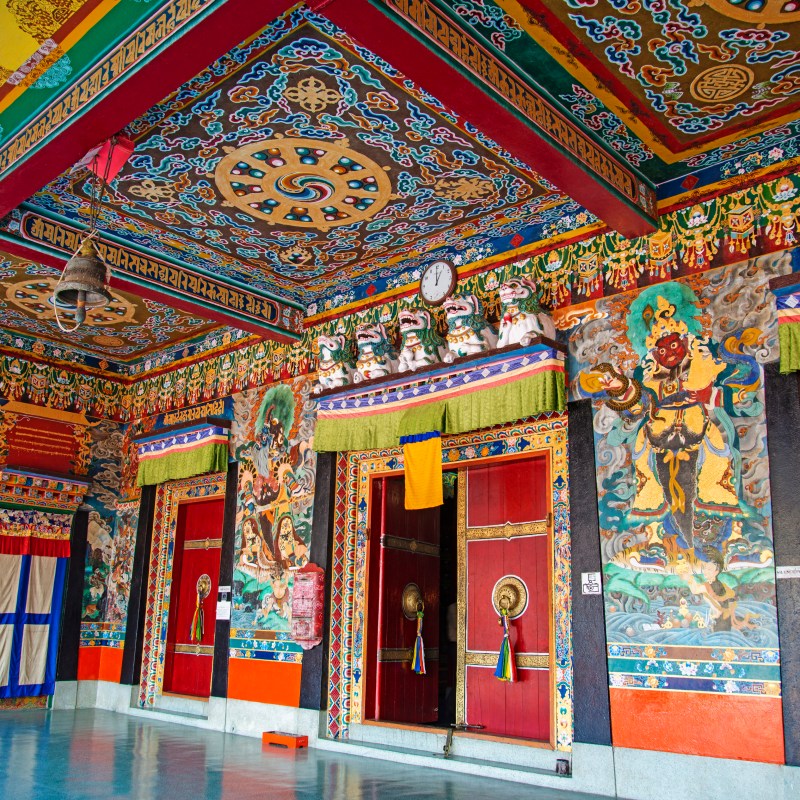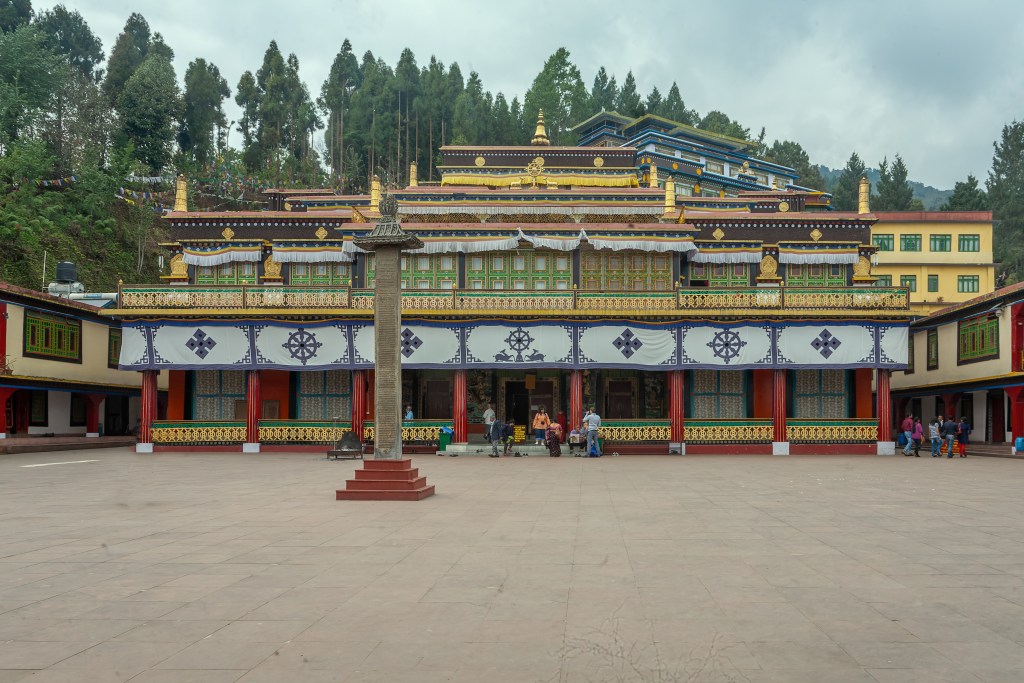
[The World Tour of Oopsies is an ongoing series of travel stories about my first decade of travel. During these adventures and misadventures, I had to unlearn many things I thought I knew about life. Welcome to my miseducation.]
Videos by TravelAwaits
Catch up on the World Tour of Oopsies travel stories:
- Chapter 1: The Scorpion
- Chapter 2: The Bucket Shower
- Chapter 3: The Goat Sacrifice
- Chapter 4: The Idol
- Chapter 5: The Boot
Part I / Still in the Himalayan Foothills
After not passing the vibe check in a small town in the Himalayan foothills (see: Chapter 5), our small group of rag-tag Western youths packed back into those hefty Jeeps to weave through the mountains once more.
And our destination was finally within reach: Rumtek Monastery.
Though I’d been handed a whirlwind front-row seat to Hindu worship at the Kalighat Temple in Kolkata (see: Chapters 3 & 4), the main focus of our trip was to learn more about Tibetan Buddhism.
And not just Tibetan Buddhism, but Tibetan culture. Sikkim, though located in India, has one of the world’s largest populations of Tibetans. That’s because many live in exile from China.
As with other topics in my world tour of travel stories, I’m going to leave the heavy lifting in terms of history and culture for more qualified sources—but you should know that, along with the Indian city of Dharamshala, the state of Sikkim is home to tens of thousands of Tibetans who left China during the diaspora of the 1950s and 60s.
Battling religious persecution, Tibetans fled to India, Bhutan, and Nepal, where tens of thousands remain today. Dharamsala is famously the home of the Dalai Lama—but he’s not the only major leader (called a lama) in Tibetan Buddhism.
There are four major sects, and each has its own system of identifying the next leader to be reincarnated into the same line (called a tulku).
To grossly generalize, lamas predict where they’ll be born in their next life so that other members of the religion can find and identify them. (If you’ve seen Avatar: The Last Airbender, that probably sounds familiar.) At least, that’s been the case historically; the Dalai Lama has been making changes during his rule.
If you click on that link right above, you’ll see a young lama sitting before a picture of the Dalai Lama. That’s who we’re talking about today: the 17th Karmapa and leader of the Karma Kagyu sect, who lived and was educated at Rumtek Monastery for over a decade.
You know, the same place that me and that group of rowdy Western youths was barreling toward in a crammed caravan of Jeeps.
Part II / Rumtek Monastery

Rumtek Monastery was built in the 1960s by the 16th Karmapa Lama after being exiled from Tibet. With the help of Sikkim’s royal family (remember, they were around until the 1970s), a large monastery and college (Rumtek) were built just outside Sikkim’s capital city of Gangtok.
To this day, it remains an important center where Karma Kagy rituals and practices are performed, which have been in place since the 12th century CE.
Again, though not quite as rock-star as the Dalai Lama, the Karmapa also exercises great power when it comes to spirituality, culture, social organization, and even political organization for Tibetan Buddhists.
In fact, we’d been slowly educated over a week about what would be waiting for us at Rumtek Monastery, how to prepare for the silent retreat we’d be doing there, and how not to get in the way of a bunch of semi-enlightened monks.
I remember feeling particularly irate upon arrival, having just learned that some Buddhist sects don’t believe women can attain enlightenment or are fit for leadership positions.
As with Hinduism, I’d helped myself to Buddhist teachings and religious texts while a high schooler living in the Midwest—but lacked real-world knowledge of the religion and its beliefs.
I’d over-romanticized everything. And now, I was in a very prominent monastery, preparing to meet one of the Karmapa’s regents. (A regent is an authority figure who is partly responsible for identifying the previous Karmapa’s latest tulku.)
In short, I no longer knew what to expect from the experience. And though I didn’t know it yet, that’s usually a great place to be when it comes to travel.
Part III / The burp
I have two important memories from Rumtek Monastery. The first is when our small group arrived, settled in, and received a meeting with one of the Karmapa’s regents.
As outlined above, this regent was one of the leaders who had helped identify the next Karmapa. But this was back in the 1980s, and China was still looking to root out Tibetan Buddhist influence in Tibet. What followed was a two-decade-long effort to get the young Karmapa out of Tibet and into Sikkim.
In other words, though we didn’t have a face-to-face with the Karmapa, meeting with one of his regents was a big deal.
I don’t remember what kinds of questions we asked—or if the meeting was even open to questions. All I remember is that, multiple times during the interaction, this very important regent who had helped the 17th Karmapa flee China, burped loudly and freely.
Cut to that one chapter from The Little Prince when the author talks about how no one took the Turkish astronomer seriously because of his outfit. It was like rereading that chapter and having my mind blown all over again—
I hadn’t realized that professionals and spiritual leaders of the highest order would burp freely. Like, mid-sentence.
Look, I know it’s weird and un-glamorous, but this was a very profound moment that made me realize I might not actually know true wisdom even if I looked it right in the eyes—and, in this case, because I was raised to avoid burping.
It was like the bucket shower all over again (see: Chapter 2), in which I ended up learning more about myself and my outlook on life than I’d planned. A good term for this is transformational travel, when we allow our experiences to reshape our worldview. But that sounds a little boring, academic, and possibly even hoity-toity, so I usually call it unlearning.
Try thinking about it like that the next time you pack your bags for a world tour. What will you unlearn on your next adventure?
